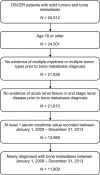Prevalence of renal impairment and use of nephrotoxic agents among patients with bone metastases from solid tumors in the United States
- PMID: 25663171
- PMCID: PMC4430264
- DOI: 10.1002/cam4.403
Prevalence of renal impairment and use of nephrotoxic agents among patients with bone metastases from solid tumors in the United States
Abstract
The renal status of patients with bone metastases secondary to solid tumors and their treatment with nephrotoxic agents is not well characterized. This retrospective study analyzed electronic medical records data from US-based oncology clinics to identify adult (age ≥18) solid tumor patients with first bone metastasis diagnosis and ≥1 serum creatinine recorded between January 1, 2009 and December 31, 2013. Patients with multiple myeloma, multiple primary tumor types, acute renal failure, and/or end-stage renal disease were excluded. Using the Chronic Kidney Disease Epidemiology Collaboration formula, we determined the prevalence of renal impairment (RI: single estimated glomerular filtration rate [eGFR] value <60 mL/min per 1.73 m(2) ) and chronic kidney disease (CKD: ≥2 eGFR values <60, at least 90 days apart). We also examined the use of intravenous bisphosphonates (IV BP) and other nephrotoxic agents. Approximately half of the 11,809 patients were female. Breast (34%) and lung (28%) tumors were the most common. At bone metastasis diagnosis, mean age was 67 years and 24% of patients exhibited RI. The 5-year prevalence was 43% for RI and 71% for CKD among RI patients. Nearly half (46%) of CKD patients received IV BP in the 12 months following their confirming eGFR and 13% of these patients received at least one other nephrotoxic agent during that period. This is the first US-based study to examine the prevalence of RI among patients with bone metastases from solid tumors. RI is common at bone metastases diagnosis, and a substantial proportion of patients develop RI or CKD as their disease progresses. Whenever possible, treatments that are potentially less damaging for the kidney should be considered for patients with or predisposed to RI.
Keywords: Bone metastasis; chronic kidney disease; intravenous bisphosphonates; renal impairment; solid tumor.
© 2015 The Authors. Cancer Medicine published by John Wiley & Sons Ltd.
Figures
References
-
- Salahudeen AK. Bonventre JV. Onconephrology: the latest frontier in the war against kidney disease. J. Am. Soc. Nephrol. 2013;24:26–30. - PubMed
-
- C-KIN/Cancer & the Kidney International Network . Available at http://www.c-kin.org/about-c-kin/ (accessed 17 November 2014)
-
- Perazella MA. Moeckel GW. Nephrotoxicity from chemotherapeutic agents: clinical manifestations, pathobiology, and prevention/therapy. Semin. Nephrol. 2010;30:570–581. - PubMed
-
- Cheng TY, et al. Mortality risks for all causes and cardiovascular diseases and reduced GFR in a middle-aged working population in Taiwan. Am. J. Kidney Dis. 2008;52:1051–1060. - PubMed
Publication types
MeSH terms
Substances
LinkOut - more resources
Full Text Sources
Other Literature Sources
Medical
Molecular Biology Databases
Research Materials
Miscellaneous



